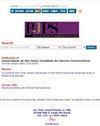Role of Brain Angiotensin-II in Development of Experimental Diabetic Nephropathy in Wistar Rats
IF 0.9
4区 医学
Q4 PHARMACOLOGY & PHARMACY
引用次数: 0
Abstract
The renin-angiotensin-aldosterone system (RAAS) plays a key role in diabetic nephropathy (DN). Angiotensin-II secreted during the RAAS pathway increases nephropathy. It stimulates oxidative stress which can quench nitric oxide. Reduced nitric oxide level aggravates Ang-II-induced vasoconstriction. Ang-II has also emerged as a central mediator of the glomerular hemodynamic changes that are associated with renal injury. Deletion of ACE2 is also noted due to increased Ang-II level which leads to the development of DN. We hypothesize that nephropathy caused by Ang-II in the periphery may be controlled by brain RAAS. ACE inhibitors and ARBs may show the renoprotective effect when administered through ICV without crossing the blood-brain barrier. DN was observed after 8 weeks of diabetes induction through alloxan. Administration of captopril and valsartan once and in combined therapy for 2 weeks, significantly reduced urine output, blood urea nitrogen, total protein in the urine, serum cholesterol, serum creatinine, serum triglycerides, and kidney/body weight ratio as compared to diabetic control rats. Further, combination therapy significantly increased the body weight and serum nitrate level as compared to diabetic control animals. However, increased ACE2 levels in the brain may reduce the sympathetic outflow and might have decreased the peripheral activity of Ang-II which shows beneficial effects in DN.脑血管紧张素- ii在Wistar大鼠实验性糖尿病肾病发生中的作用
肾素-血管紧张素-醛固酮系统(RAAS)在糖尿病肾病(DN)中起关键作用。在RAAS通路中分泌的血管紧张素- ii增加了肾病。它能刺激氧化应激,从而抑制一氧化氮。一氧化氮水平降低加重ang - ii诱导的血管收缩。Ang-II也已成为肾小球血流动力学变化的中心介质,与肾损伤相关。由于Ang-II水平升高,ACE2缺失,导致DN的发生。我们推测外周Ang-II引起的肾病可能受脑RAAS的控制。ACE抑制剂和arb在不穿过血脑屏障的情况下通过ICV给药时可能显示出肾保护作用。四氧嘧啶诱导糖尿病8周后观察DN。卡托普利和缬沙坦联合用药1次,联合治疗2周,与糖尿病对照大鼠相比,显著降低尿量、血尿素氮、尿总蛋白、血清胆固醇、血清肌酐、血清甘油三酯和肾/体重比。此外,与糖尿病对照动物相比,联合治疗显著增加了体重和血清硝酸盐水平。然而,大脑中ACE2水平的升高可能会减少交感神经流出,并可能降低Ang-II的外周活性,这对DN有有益的影响。
本文章由计算机程序翻译,如有差异,请以英文原文为准。
求助全文
约1分钟内获得全文
求助全文
来源期刊

Brazilian Journal of Pharmaceutical Sciences
PHARMACOLOGY & PHARMACY-
CiteScore
1.40
自引率
0.00%
发文量
165
审稿时长
7.5 months
期刊介绍:
The Brazilian Journal of Pharmaceutical Sciences accepts for publication Original Papers applicable to the fields of Pharmaceutical Sciences; Reviews and Current Comment Articles, which are published under the Scientific Editor and Associate Editors invitation to recognized experts or when they are spontaneously submitted by the authors in the form of abstracts to have their importance evaluated. A critical view of the subject with insertions of results of previous works in the field in relation to the state of art must be included; Short Communications reporting new methods and previews of works on researches of outstanding importance in which originality justify a quick publication. A maximum of 2000 words excluding tables, figures and references is an acceptable limit. One table, one figure and ten references may be added, and Book Reviews of the latest editions of books, prepared by specialists invited by the Scientific Editor and Associate Editors. Thematic Supplements as well as those related to scientific meetings can be published under the Scientific Editor and/or Associate Editors agreement.
 求助内容:
求助内容: 应助结果提醒方式:
应助结果提醒方式:


